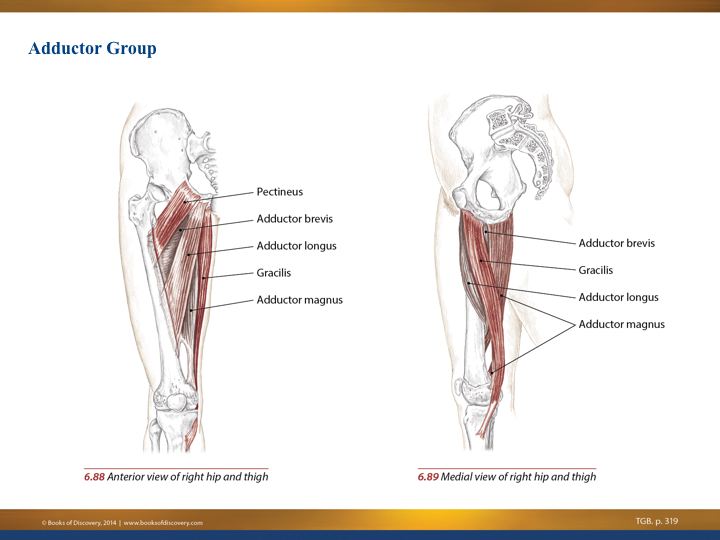Adduction is the movement of a body limb toward the mid-line. In the hip, it’s the action of the femur (leg) coming closer to the middle of the body (or other leg). Hip adductors are muscles that bring the femur toward the midline.
Hip abductors are muscles on the other side of the leg and they do the opposite motion, by bringing the leg away from the middle of the body. It would look funny if humans stood around adducting and abducting their leg, but it’s more complex than that…
Adductors are 5 of 21 muscles all contributing directly to hip movement in various ways. The way that these muscles contribute to normal human movement, such as walking, sitting in a chair, etc. is quite complex – so let’s start with the basics.
Hip adductors are found on the inner thigh.
The five muscles usually termed as hip adductors are:
1. Pectineus
2. Adductor Longus
3. Adductor Brevis
4. Gracilis
5. Adductor Magnus
and I just learned about one more in Feb 2018:
6.Adductor Minimus!?
I listed the muscles in the order above for a reason. When following the pelvis from top/front to bottom/back, this is the order of attachment. When I teach anatomy workshops and courses I have students create an acronym to remember these muscles.
It’s your turn!
P, L, B, G, M. What acronym can you create to remember this order?
Pretty Little Babies Get Milk.
Poor Little Boys Go Manic.
Have fun with it!
Share your acronym in the comments below.
Next, learn the attachments of the muscles.
1. Pectineus: pectineal line of the pubic bone to pectineal line of femur (inferior to lesser trochanter)
2. Adductor Longus: pubic body just below pubic crest to middle third of linea aspera
3. Adductor Brevis: anterior surface of ramus to upper linea aspera
4. Gracilis: anterior surface of ramus to pes anserine on medial tibia
5. Adductor Magnus: pubis and tuberosity of ischium to linea aspera and adductor tubercle on inferior medial femur.
6. Adductor Minimus: inferior ramus of pubis at anterior portion of adductor magnus to medial lip of linea aspera.
The attachment names can be confusing, so I like learning where they are on my body, instead of getting lost in the names. Use an anatomy book and this video to assist you and find the attachments on your own body.
You can find your own Adductor Longus by finding the large cord in your groin. The tendon is very prominent. Follow it into your pubic bone. Directly above it is your Pectineus and below it is Adductor Brevis and Gracilis. Adductor Magnus is found directly between your thighs on the ramus bone.
Trade in Memorizing for Body Awareness
Memorizing the names of muscle attachments can be tricky. Stick to learning the muscle names and finding the muscles on yourself, this is the knowledge you really need. Knowing each muscles location on your own body helps you enhance your body awareness and create exercises. It helps you identify weak muscles on yourself and strengthen them. Then, you can repeat this process with clients.
Exercise Programming
All of the adductors have adduction as a common movement, but you can change which ones are prime movers by rotating the femur internally or externally. Give it a try! Lie on your side and lift the bottom leg up to call the adductors into action. Now, rotate the femur slightly and note what changes. You can also do this laying on your back with a small ball between the knees and pressing into it gently with one leg at a time.
I like to compare clients right and left side body awareness to one another, and locate differences between the sides. It guides me when creating an exercise program that is very specific to their needs.
Example
If a client externally rotates their femur and adducts with ease on the right side, but feels weak or has to bend their knee on the left side, I identify the left side as needing body awareness and strengthening. I spend more time with them working on that side. I review the muscles with them and proper mechanics. It’s an investigation process.
If they have trouble recruiting the muscle when lying down, imagine what happens in bigger moves like squats…
Sometimes the weakness is there due to injury, which is why it’s important to know your clients health history. Don’t try to train someone through pain, it may get you (and them) in trouble.
Expand your anatomy knowledge with NFPT’s Fundamentals of Anatomy Program.
Balloons, play-doh, pipe cleaners and ribbons are used to demonstrate each muscle with its attachment point on a skeleton model in a series of videos. You’re also shown how to find the attachments on yourself and/or clients. Application exercises and guided visualizations are also provided along with a 50-page workbook.



